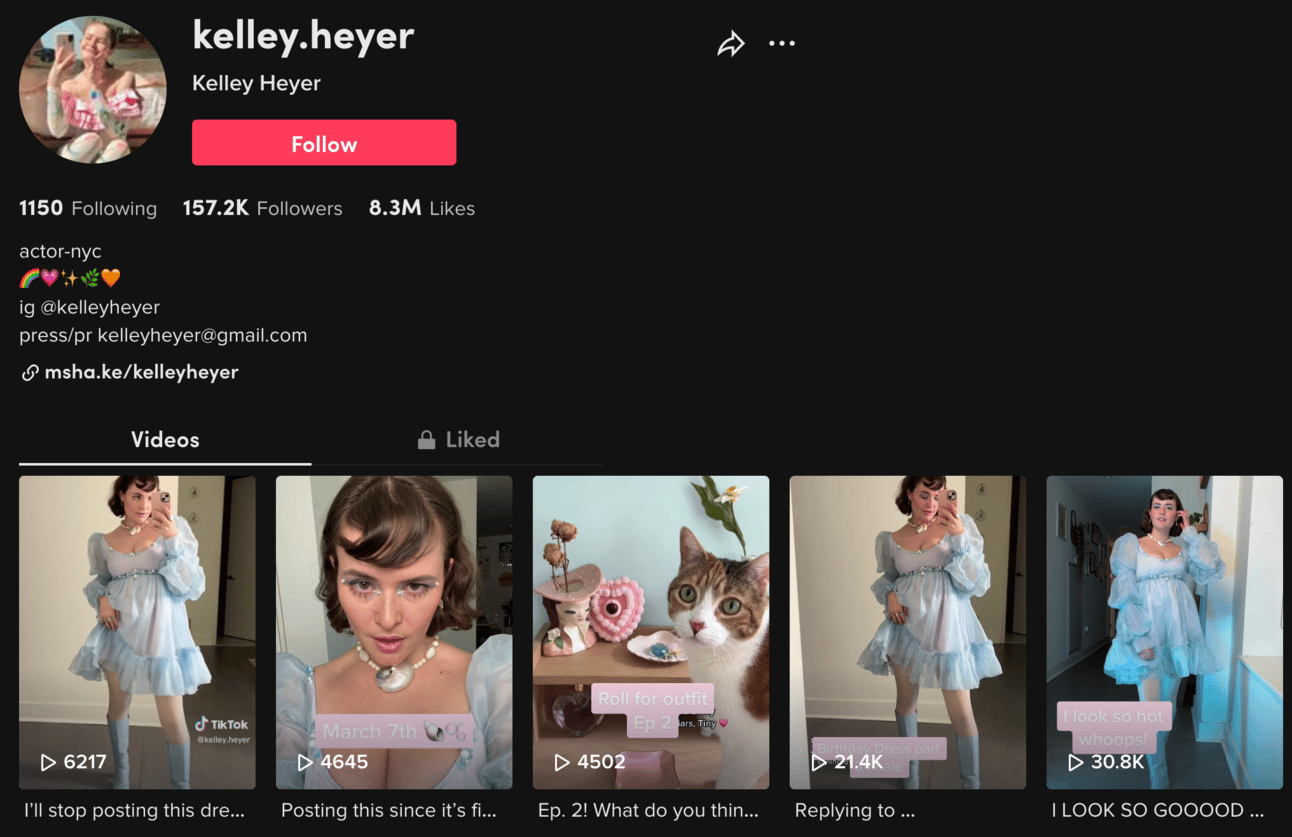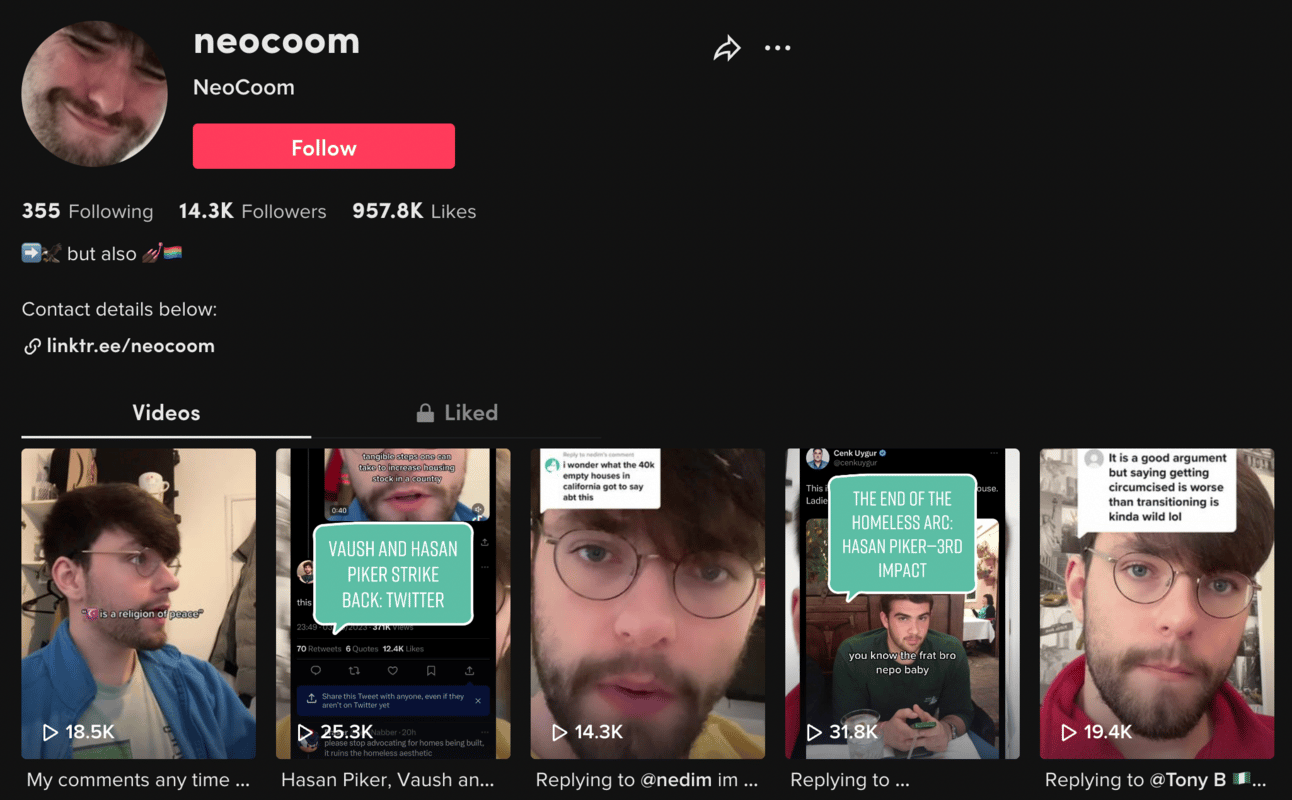A Baseline Of Assumed Cringe
In February, the online folie à deux that is Twitter and TikTok latched on to the concept of “thrift shops” and basically tore themselves apart about it incessantly. By the time I finally wrote about it, it was entering its third week.
Twitter users, in particular, became fixated on Depop resellers, arguing that it was classist to buy old clothes from thrift shops and sell them at a premium. (No, it isn’t.) And, interestingly enough, TikTok users have now found a different, but equally silly thing to be angry about: altering second-hand clothes.

Six days ago, a TikTok user named Kelley Heyer began documenting the alterations she was doing to a “vintage 70s dress” that she bought online. The first video she posted of the dress was watched over a million times and the comments are wild.
In a follow-up video, though, Heyer explains that the dress cost around $50, she bought it on eBay, it wasn’t particularly special or even well made, and she thinks it was a prom dress or maybe something used in a theater production.
I, personally, think she may have made a mistake initially calling the dress “vintage,” which made all the children on TikTok think it was somehow special or valuable. I also, unfortunately, do think the dress looked better before she alte— no, I will not get sucked into this!!!
After she debuted the new version of the dress, people went even more ballistic and Heyer had to do another follow-up video. She’s posted about the dress at least four more times since the first video and each time there were weirdos grumbling about the original dress design in the comments. Heyer even drew up a list of other dresses people could buy on eBay if they so choose. Though, I doubt anyone did. Because that’s not what this is about.
I’ve seen this same knee-jerk response around renovation and home remodeling content. Once a week, it feels like, someone shares a video of a TikTok house flipper “destroying” an old house. The old houses, I’d say 85% of the time, are usually both ugly and impractical. This isn’t a TikTok, but from an Instagram project, but the reaction is exactly what I’m talking about:
I’m sorry, I’m a borderline hoarder who loves buying old weird dumb shit and filling my house with it and even I can tell you that the new bathroom on the right loo— no I’m not doing this!!
I’ve seen a bunch of different arguments for why social media feels like this more than it used to. Concepts I’ve come across like “feelings yakuza” or “the trashed bathroom theory” explain some of this to an extent, but not all the way. I also think it’s a broader trend, one I’m seeing across numerous online subcultures. So what’s the deal? Well, my personal theory is that because we’re being bombarded by content all day, every day now and almost all of it is stripped of its original context, we’ve begun to build our own. And because we can’t possibly know information that we don’t have, we’re basing that context off whatever platform it looks like the piece of content originally came from.
Here, let’s try a little exercise: I want you to imagine you just saw a random TikTok or TikTok-like video shared on Twitter or Tumblr or Reddit, but you haven’t pressed play yet. Then I want you to think about whether or not you expect that TikTok to be “good” if you were to click on it. As in, I want you to question what your expectations are of the content before you watch it. Similarly, I want you to imagine seeing a screenshot of a tweet on, say, Instagram. And, once again, I want you to think about what you expect upon reading that tweet. I’m going to guess that you expect the TikTok to deliver something cringe, out of touch, or mildly grotesque even. And I’m going to guess that you expect the tweet to say something concise and funny. In a sense, platforms have stripped all of our content of context and also become their own context, even if what’s being shared doesn’t fit that context.
One of the most interesting things about being in a more online world than we used to be is that we, as a population, have not only learned how to express ourselves with social platforms, we’ve begun to create preconceived notions about why we share that content both within and across platforms. People typically share TikToks because they’re bad and people tend to screenshot tweets because they’re funny. If you see a young woman cutting up an old dress on TikTok, your knee-jerk reaction to assume it’s for a bad reason. And while this is most acute on Twitter and TikTok, it’s not unique to just them. Think about your pre-reaction before reading a screenshot of, say a Reddit post — especially one with ages in the title.
And I think once you acknowledge that TikTok content is all sort of operating at an unspoken, but innately felt level of assumed-cringe it’s easier to understand why everyone’s so mad all the time. They’re here to be mad. That’s the point. If they wanted to like your content they’d have seen somewhere else.
True Posters Subscribe To Garbage Day
Subscribe to Garbage Day if you haven’t yet! It’s $5 a month or $45 a year and you get Discord access and bonus weekend issues. Don’t read the whole internet. Pay me to do it for you instead! Hit the green button to learn more.
How MrBeast Sees The World
The clip above is from MrBeast’s appearance Joe Rogan’s podcast last year, but I think it’s a very good look at how he views both “content” and his business, which is to say, they’re one and the same for him. I was asked about MrBeast on the very good Insurgents podcast this week and I think this clip basically captures his whole deal.
For MrBeast, a video is a math formula and he’s constantly tweaking the integers to gain more followers, more views, and, thus, more ad revenue. And while most creators think this way, he also backs this up with a factory-like production line. It’s about getting the numbers on each side of the equation exponentially bigger.
What I think is interesting is that, in the abstract, this all sounds pretty professional. You could almost imagine the MrBeast method working for anyone trying to build a digital media brand. Of course, that only works if you divorce the production of his content from what it actually looks like. You can easily forget that when you treat your content like a math equation for viral traffic it all ends up looking like this:

The TikTok Guy With The “Voice”

lol I know I just spent a whole lot of time above talking about inherent silliness of Twitter-to-TikTok outrage cycles, but I think this is a bit different. This account is called @neocoom, which I have to assume is a reference to the derisive 4chan term “coomer,” which is a sub-type of a wojak meme that makes fun of men who are addicted to masturbating.
So this guy’s videos are unabashedly right wing and borderline fascist. And nothing he’s doing really is all that original, but the reason I wanted to talk about it is because of his absolutely unhinged voice. You can listen to how he sounds here without giving his videos any traffic.
At first I thought he was just like one of those guys you see at Yu-Gi-Oh! tournaments that talk like supervillains. You know, real Dr Robotnik of the Taco Bell parking lot energy. But I went back all the way through his account and he was posting about Northern Ireland politics and sharing videos that seemed as if they were shot in the UK, so now I just think he has a totally whacked out British accent. Either way, his voice literally my skin crawl, especially when he talks directly into his phone’s mic. Also, it looks like he goes to the same Supercuts that MrBeast goes to.
What’s Coming Next For AI
Now this is The Good Shit. If you click through the thread above from media researcher Roland Meyer, you’ll see a bunch of absolutely fascinating examples of a generalized AI art aesthetic. God, I am so into this idea. In fact, last month, I wondered if this exact thing might happen. Whether the human brain would start to notice all the hallmarks of generative-AI art and start to recognize it as a specific style. I mean, it only took us like six months to start to recognize “NFT art” as a specific look and feel.
Meyer defines the AI art aesthetic in a few ways, “fluffy glamor glow,” a “preference for contrasting warm earth tones with blue-greenish metallic colors,” and “symmetrical compositions or forced perspectives”. Meyer also touches on what I think is the coolest part of this though, which is that AI art is generated from millions of images on the web. Which means that we’re not just seeing the emergence of a shared aesthetic for AI art, but a shared aesthetic for digital art.
I’m also a big believer in the idea that to name something is effectively kill it. Or, at the very least, by naming it you sort of lock it in place. Which makes me wonder if generative-AI art is going to be looked back on as a revolution in art for a very different reason than AI evangelists think it will be. It’s basically going to make everyone want to make stuff that DOESN’T look like this.
Three other AI things that I wanted to flag before we move on. First, if you’re curious what a GPT-3 hackathon produces, here’s a good thread. Second, Twitch is cracking down on deepfakes, banning the “promoting, creating, or sharing synthetic” non-consensual sexual content. As far as I know, this is the hardest stance any major platform has taken publicly so far. And, third, a company hooked up ChatGPT to a radio station. Just in case you needed a new job to add to the “replaced with an AI” list.
Amazon’s Maybe Dropping NFTs Soon
Several crypto news outlets are reporting that an Amazon NFT marketplace could launch as soon as next month. Based on the rumors circulating, the NFTs would be purchased with whatever card you have on file with Amazon and they would be somehow tied to a physical good. You might be scratching your head as to why Amazon would be interested in this sort of thing, but I imagine it’s about building out more royalties for secondary sales on the platform. It’s one of the things NFTs are actually pretty good about, i.e., when you buy something tied to an Amazon NFT and then sell it (on Amazon) with the NFT, Amazon would, at least in theory, get a cut, as well.
Probably best not to think about how much of a huge buy-in this would require from users who probably don’t want to deal with any of this.
Maybe the guy who spent $2.5 million trying to recover a hard drive that, it turned out, had Bitcoin Cash on it instead of Bitcoin can get in on the ground floor of the Amazon NFTs.
The Naruto Guy Is Still At It
Everyone’s still upset with the Corridor Crew for turning themselves into “an anime” with Stable Diffusion. Well, what about this absolute legend who is spending 150 days recreating a Naruto trailer shot by shot?
Good Tweet
Some Stray Links
P.S. here’s a good cat video.
***Any typos in this email are on purpose actually***